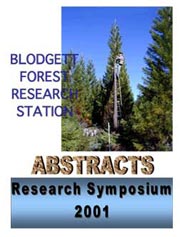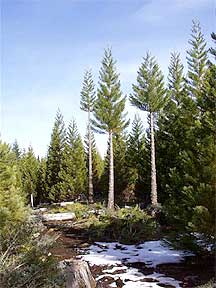 |
||||||||||||||
|
||||||||||||||
| 2001 Blodgett Forest Research Symposium |
| Research Projects | Research Publications | Back to TABLE OF CONTENTS |
|
|||||
Problem issue: Recent growth and yield data for young growth Giant Sequoia (Sequoiadendron giganteum) (Heald/Barrett) has demonstrated the wide variation in early (0-10 yr.) growth rates of sequoia as affected by planting density. The species has excellent potential wood quality for various high value end products (fence boards, decking, interior and exterior trim) quite similar to Coastal Redwood (Sequoia sempervirens). A vast area of the middle elevation west-side Sierra Nevada mixed-conifer vegetation type seems suitable for sustainable production of Sierra Sequoia young growth. This potential could drastically reduce the market demand pressure for increasingly short rotation management of coastal redwood stands. However, the higher value redwood end products require clear heartwood. Sierra Sequoia exhibits virtually no self-pruning even at the closest spacings (2 M) in planted stands through age 30. Naturally regenerated extremely high-density (>5,000 TPHa) stands (Metcalf) also show little effective self-pruning for their first century of growth. The number of branches per unit of stem length seems little effected by early stand density in planted stands. Average branch diameters at age 10 range from about 1.2 cm to 2.4 cm in diameter as spacing increases from 2 M to 6 M. thus, while spacing does affect diameter and height, branch sizes remain well within the range that can easily be pruned by standard lopper and saw pruning tools. Little is known about the stem growth, epicormic branching potential, heartwood formation and stem taper effects of pruning Giant Sequoia. Studies underway at Blodgett Forest (1996 Heald/Schurr) indicate very little epicormic branching after pruning 15 year old sequoia in mixed species plantations to 2 m, 3.5 M, and 5.5 M in one lift where plantation canopies were nearly closed and trees averaged 10 M in height. Anecdotal observations of other sequoia prunings show a wide range of epicormic branching response to pruning. Methods: This study will prune plantation sequoias over a wide range of spacing and live crown removal intensities throughout an entire calendar year. Two variables will be introduced: T: Time of pruning; replicated each calendar month. I: Pruning intensity: 20% to 90% of total stem height. C: Control – No treatments. The study is located within an existing sequoia density study at Blodgett Forest in its 12th growing season. The guard row trees in each of 3 replications of the 9 initial spacings will be randomly selected for treatment. Forty-five Sequoias will be pruned each month, some to each of 2 M., 3.5 M, and 5.5 M heights. Initial Data Collected: Presence of existing branch and branch collar epicormic branches. Tree height, height to base of live crown, and height to base of pruned live crown. Stem diameter at base, breast height, 2 M, 3.5 M, and 5.5 M. Interior branchlets alive or dead on uppermost pruned branches. Response Data: Initial appearance month, number, location and size of new epicormic branches will be tracked each month for the first year, epicormic branch and size will be measured once annually for 3 years. Total height and height to base of live crowns, stem diameter and heartwood formation at base, breast height, 2 M, 3.5 M, and 5.5 M will be measured after 3 years.
|
|||||
Contact Author: Robert C. heald, Director, Center for Forestry, University of California, Berkeley, Blodgett Forest Research Station, 4501 Blodgett Forest Road, Georgetown, CA 95634, (530) 333-4475, e-mail: bheald@nature.berkeley.edu |
|||||
|
|||||
|
University of California Center for Forestry, UC Berkeley. Last modified: 6/27/02 ©Copyright, 2001. The Regents of the University of California. For questions and comments, contact webmaster. |


